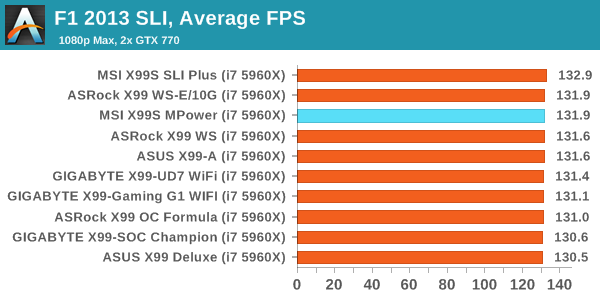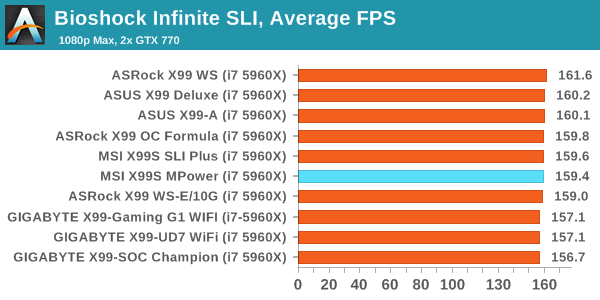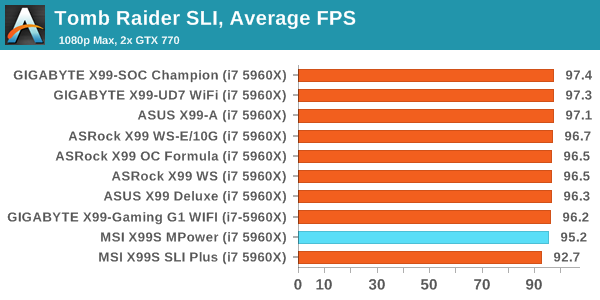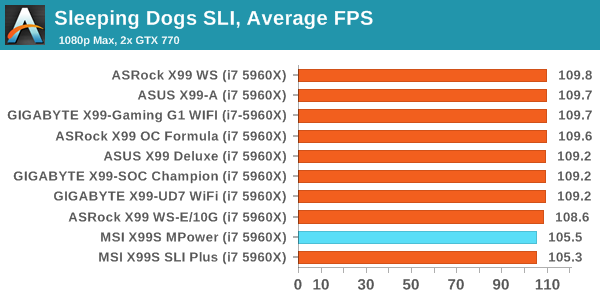MSI X99S MPower Review: Sting Like a Bee
by Ian Cutress on February 17, 2015 9:00 AM EST- Posted in
- Motherboards
- Intel
- MSI
- Overclocking
- X99
Gaming Performance
F1 2013
First up is F1 2013 by Codemasters. I am a big Formula 1 fan in my spare time, and nothing makes me happier than carving up the field in a Caterham, waving to the Red Bulls as I drive by (because I play on easy and take shortcuts). F1 2013 uses the EGO Engine, and like other Codemasters games ends up being very playable on old hardware quite easily. In order to beef up the benchmark a bit, we devised the following scenario for the benchmark mode: one lap of Spa-Francorchamps in the heavy wet, the benchmark follows Jenson Button in the McLaren who starts on the grid in 22nd place, with the field made up of 11 Williams cars, 5 Marussia and 5 Caterham in that order. This puts emphasis on the CPU to handle the AI in the wet, and allows for a good amount of overtaking during the automated benchmark. We test at 1920x1080 on Ultra graphical settings.

Bioshock Infinite
Bioshock Infinite was Zero Punctuation’s Game of the Year for 2013, uses the Unreal Engine 3, and is designed to scale with both cores and graphical prowess. We test the benchmark using the Adrenaline benchmark tool and the Xtreme (1920x1080, Maximum) performance setting, noting down the average frame rates and the minimum frame rates.

Tomb Raider
The next benchmark in our test is Tomb Raider. Tomb Raider is an AMD optimized game, lauded for its use of TressFX creating dynamic hair to increase the immersion in game. Tomb Raider uses a modified version of the Crystal Engine, and enjoys raw horsepower. We test the benchmark using the Adrenaline benchmark tool and the Xtreme (1920x1080, Maximum) performance setting, noting down the average frame rates and the minimum frame rates.

Sleeping Dogs
Sleeping Dogs is a benchmarking wet dream – a highly complex benchmark that can bring the toughest setup and high resolutions down into single figures. Having an extreme SSAO setting can do that, but at the right settings Sleeping Dogs is highly playable and enjoyable. We run the basic benchmark program laid out in the Adrenaline benchmark tool, and the Xtreme (1920x1080, Maximum) performance setting, noting down the average frame rates and the minimum frame rates.















12 Comments
View All Comments
Horza - Tuesday, February 17, 2015 - link
Thanks for the review but no info regarding the power delivery? It's the first thing I look into with an overclocking board. More for reliability than any extra clock speed. I'm aware phase count is not always a useful metric but it would be nice to include it.Anyway it's 12 phase a "ISL6388 6-phase PWM" with doublers. "Fairchild FDMF5823DC MOSEFTs" rated 55a. Twelve Solid Ferrite Chokes (SFC). Memory is "Two Powervation PV3203 controllers"
tabascosauz - Tuesday, February 17, 2015 - link
Every manufacturer appears to be cheapening their boards that carry over from Z87 to Z97, but on X99, this is quite disappointing to hear. IR3550s are expensive, but an analog PWM on an overclocking board? This is a surprising choice, especially in the light of Asus' and GB's X99 boards. The X99 Deluxe pairs the nice "Blackwing" chokes with IR3550Ms, although it costs way more. Even the UD7, a non-OC geared board, comes in at just $20 more with the usual GB fare: all new IR, from the IR3580 PWM to the IR3556s.The ISL6388 is disappointing. This doesn't belong on MPower. So what if the FDMF5823 is one of Fairchild's DrMOS top-of-the-line products? The ISL6388 is on a completely different level. MSI has always flaunted their "Solid Ferrite Chokes" while hiding crappy MOSFETs/PWMs under heatsinks since Z77.
Antronman - Tuesday, February 17, 2015 - link
In the end, the serious OC purchase will always be ASUS' Rampage Extreme series. I don't understand why you'd cheapen your overclock with a board that has cut high-end features to lower the cost on the most expensive consumer platform.KennyDude27 - Wednesday, March 4, 2015 - link
Actually analog PWM or digital PWM doesn't mean one is better than the either. An analog pwm can be just as good if not better than a digital pwm and these days digital and analog is so obscure.If you mean digital control loop vs analog loop its hard to tell which is totally better. As long as the control loop is making the right decisions in the right amount of time it doesn't matter if its digital or analog. Phase shedding or increasing can be done in analog or digital as long as its done. Digital control loops do offer non linear control so you can do things such as have smaller caps but analog interfaced with digital can do the same and at much less power usage. The one issue with digital control is the process time so your limited to how fast the clock can run. Thats why they use alot of phases, it makes it so that the slow digital loop can handle it by dividing the time by the number of phases so you might be using a board that has more phases not for you but to help the digital control loop out since digital loop requires processing time to do its computation and control. So as switching speeds increase digital control may have a harder time while analog pwm can go to 20mhz or more no problem.
In the end its whichever solution gives the best performance and features people are willing to pay for
DanNeely - Tuesday, February 17, 2015 - link
I'm mildly surprised that MSI decided that this board could make due with only 2 12V connectors. The Z97 MPower used 3: 8pin, 4 pin, and 6pin PCIe; but its CPUs are lower power and is maxes out at 3GPUs vs potentially 4 here (with water cooling and if you can remove the video out ports on one card).29a - Tuesday, February 17, 2015 - link
What does 3DMark2001 XP Turbo in the BIOS do?Horza - Tuesday, February 17, 2015 - link
Boosts 3DMark2001 scores I'd imagine. My Gigabyte board has a similar "Legacy Benchmark Enhancement" setting in the bios which apparently boosts 01 score and SuperPi.kmmatney - Tuesday, February 17, 2015 - link
I just don't get why anyone spends $250+ on a motherboard. I've always been able to overclock my cpus quite high (better than the average, let's say) using motherboards that are virtually free with a Microcenter CPU+MB bundle. The last few motherboards have been the MSI PC-Mate Z77, and I was able to overclock both a G3258 and a Devil's Canyon Core i5 to levels on par with the Anandtech review of those respective cpus. The cpu heatsink makes more of a difference than the motherboard. I haven't had any stability problems overclocking, going back over 10 years, with basic motherboards. Once you have a good overclock and stability, what more do you need?Zap - Wednesday, February 18, 2015 - link
You can't directly compare pricing of socket 2011 motherboards versus socket 1150 motherboards. They are entirely different beasts.As for the exact same platform, more money gives more features. Also, some people can afford to spend more, and enjoy owning a "premium" product.
Why does someone pay for an iPhone when they can use a "almost the same" $100 Android phone? Why does someone pay for a top end Mercedes when a loaded Camry for $30,000 has power and leather everything, plus electronic gadgets?
That said, I do agree with you to a point. Sometimes more cost means real benefits. However, sometimes that just means extra NICs and PCIe slots and fancy VRM heatsinks that you still won't use or benefit from.
nos024 - Wednesday, February 18, 2015 - link
Choosing a motherboard is important, not just for overclocking capabilities. Whether you'd want SLI, extra USBs and SATA connectors, NIC, Wifi etc, Also some would like PCI/PS2 ports to carry on perips they want to incorporate into their new build. I learned this from many builds I'd built for myself. Essentially you are stuck with the motherboard you go with. I don't totally disagree with your point, but I've learned that cheap motherboards are just that...cheap.The most I will spend on a motherboard is $200 and I am quite satisfied with my ASRock Z97 Extreme 6. It took me months of research to settle on this. I'd happily pay an extra $50-100 for something I want.